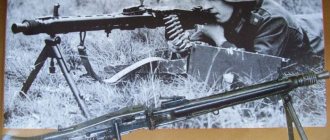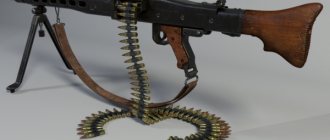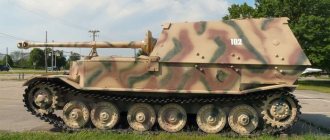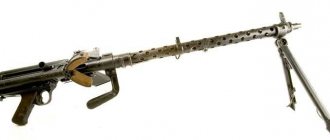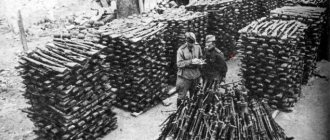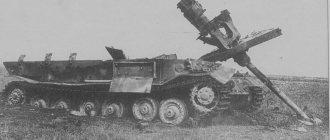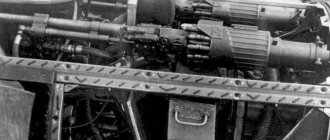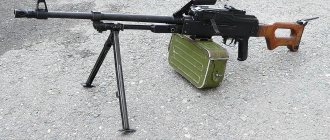History of creation
The First World War showed that a new, powerful player had appeared on the battlefield - the machine gun. The first models of machine guns were bulky and heavy. They performed excellently in defense, but it was difficult to go on the attack with a 60-kilogram colossus.
The difference between light and heavy machine guns, as well as models for equipment, led to confusion and problems with personnel. The Germans unraveled this tangle quickly and wittily. In the 1930s, the development of a single combined arms machine gun began, which led to the creation and adoption by commissions of the MG-34.
The resulting car turned out to be extremely successful.
Excellent characteristics with a relatively low weight, the ability to be installed on a machine and in turrets and caponiers made this machine gun indispensable for the Wehrmacht.
But at the same time, serious shortcomings also emerged. The price of the machine gun was 327 marks, while the Volkswagen Beetle was sold at a price of 990 marks.
Many parts were created by milling, which increased creation time and increased cost. Inspections on the battlefields also revealed design defects.
The parts fitted to each other were afraid of dirt, and problems arose with excessive complexity during assembly and disassembly and replacement of parts. However, even before the MG-34 was put into service, work began on creating a more technologically advanced model, which became known as the MG-42.
Butt plate and butt of MG-42 machine gun
The butt plate consists of a bushing with a buffer spring and a buffer mounted on it. The bushing has: crackers for a cracker connection with the box; four sector rifling for connection to the butt. The stock, made of plastic, has a clip with screw threads for connection to the butt plate and a spring latch.
Butt plate and butt of MG-42 machine gun: 62
—
butt plate bushing;
63
—
buffer spring;
64 -
butt;
65 —
butt latch.
The design of the new machine gun
Several German design bureaus received orders for a new machine gun at once. The designers of Rheinmetall coped with the task best. The designers made numerous changes to the scheme, among which the most important were the following:
- replacement of milling with stamping for a number of parts;
- replacing screw connections with riveting or soldering;
- reduction in cost due to the use of lower quality metal;
- reduction of parts by 200 pieces;
- changing the butt from wood to plastic.
The mechanics of the machine gun are based on the recoil of the barrel during a short stroke. Shooting began with cocking the long bolt handle, with the ability to put the safety on if necessary.
The impact mechanism consisted of a return spring. The rear sear ensured the shot. Pressing the trigger lowered the nose of the sear, the spring straightened and sent the bolt back. The bolt, in turn, removed the cartridge from the tape and sent it into the chamber. The shot was fired with the shutter open.
The barrel is locked by two rollers in the combat cylinder. This was quite a revolutionary decision. The parts not only ensure smooth shooting, but also reduce friction. The trigger mechanism is installed in the pistol grip, where the safety is also located.
It was possible to conduct only automatic fire.
Aiming was carried out through an open sight, consisting of a front sight and rear sight. The scale was divided into steps of 100 meters, with the ability to fire from 200 to 2000 meters. The sighting bar clamp moved with a click. It could be displayed with eyes closed or in complete darkness.
The barrel is cooled from overheating using air masses. The casing is in the form of a rectangle, with large cutouts along the body. On one side there was a hole for quickly changing the barrel.
According to the engineers' recommendations, this part had to be changed every 150 shots to prevent overheating. The main advantage of the MG-42, and at the same time the main headache, is the rate of fire. 1200 rounds per minute guaranteed and quickly killed the barrel.
The second number of the crew had with him a set of replacement barrels and an asbestos glove so as not to burn his hand. A machine gunner replaced an overheated barrel in an average of 5-8 seconds. The regulations prescribed shooting in short bursts of no more than 250 rounds to preserve the barrel. Experienced fighters could fire bursts of 3-5 shots.
Use of captured German machine guns in the USSR
Many small arms experts consider German machine guns to be the best of those used in World War II. In this case, we are usually talking about MG 34 and MG 42 machine guns. But in addition to these models, the armed forces of Nazi Germany also had other 7.92 mm machine guns.
Ammunition for German machine guns
K98k rifle cartridges were used to fire German machine guns.
The main cartridge was considered to be 7.92x57 mm sS Patrone, with a heavy pointed bullet weighing 12.8 g. In a 600 mm long barrel, this bullet accelerated to 760 m/s. At lightly armored and aerial targets, the Germans widely used cartridges with SmK armor-piercing bullets when firing. At a distance of 100 m, a bullet weighing 11.5 g with an initial speed of 785 m/s along the normal line could penetrate 10 mm armor. The ammunition of infantry machine guns could also include cartridges with armor-piercing incendiary bullets PmK
German 7.92-mm armor-piercing tracer cartridge
Depending on the combat mission, a cartridge with an SmK L'spur armor-piercing tracer bullet was loaded into the machine-gun belt every 3-5 regular or armor-piercing cartridges. An armor-piercing tracer bullet weighing 10 g accelerated in a rifle barrel to 800 m/s. Its tracer burned at a distance of up to 1000 m. In addition to adjustments and target designation, an armor-piercing tracer bullet, when penetrating the wall of a gas tank, could ignite fuel vapors.
Machine guns MG 08, MG 08/15 and MG 08/18
Let's start the story about German rifle-caliber machine guns with the MG 08 (German: Maschinengewehr 08), which was adopted for service in 1908 and was a German version of the Hiram Maxim system.
Machine gun MG 08
During the First World War, two lightweight light machine guns were created on the basis of the MG 08 - the MG 08/15 with a water-cooled barrel, which became quite widespread, and the MG 08/18 with an air-cooled barrel, produced only in small quantities (due to the end of the war).
These machine guns differed from the basic version in a lightweight receiver, wooden butt and pistol grip. To increase the mobility of light machine guns, a special box was developed for them, containing a belt with a capacity of 100 rounds, attached to the weapon on the right. But at the same time, the possibility of using a standard 250-round belt remained.
Light machine gun MG 08/15
The weight of the basic modification with the machine was 64 kg. MG 08/15 weighed 17.9 kg, and MG 08/18 - 14.5 kg. Length MG 08 – 1185 mm. MG 08/15 and MG 08/18 – 1448 mm. Rate of fire 500–600 rounds/min.
MG 08 machine guns were widely used by the Kaiser's army in the First World War and were then in service until the defeat of Germany in the Second World War. By the early 1930s, the MG 08 was already an obsolete weapon, its use due to the lack of more modern machine guns.
In September 1939, the Wehrmacht had more than 40,000 MG 08 machine guns of various modifications. The Germans also received several thousand 7.92 mm Maxim wz machine guns. 08 – Polish version of the easel MG 08.
At the first stage of World War II, MG 08 machine guns were mainly used in rear units. They were available in training, reserve and security units, as well as in permanent installations in fortified areas. But after 1943 (due to an acute shortage of new machine guns at the front), one could find frankly outdated MG 08 and MG 08/18.
However, these machine guns had one undeniable advantage. The reliable (albeit somewhat heavy) water-cooled design allowed intense fire without the risk of barrel overheating, outperforming more modern models in this regard.
Light machine gun MG 13
Due to their heavy weight, the MG 08 family of machine guns did not meet modern requirements.
And in the early 30s, several promising infantry machine guns were created in Germany, which were more in line with the military’s ideas about weapons of maneuver warfare. The first model adopted for service in 1931 was the MG 13 light machine gun, developed using the MG 08 automatic operation scheme. Specialists from Rheinmetall-Borsig AG tried to make the weapon as light as possible. At the same time, water cooling of the barrel and belt feeding were abandoned. The barrel on the MG 13 has become removable.
The machine gun was fed from a 75-round drum or a 25-round box magazine. The weight of the unloaded weapon was 13.3 kg. Length – 1340 mm. Rate of fire – up to 600 rounds/min. To reduce dimensions, the tubular stock with a folding shoulder rest was folded to the right. Along with the sector sight on the MG 13, it was possible to install an anti-aircraft ring sight.
MG 13 light machine gun, butt folded.
Although the MG 13 was in many ways superior to the standard Reichswehr light machine gun MG 08/15, it had many disadvantages: design complexity, long barrel changes and high cost of production.
In addition, the military was not satisfied with the magazine feed system, which increased the weight of the ammunition carried and reduced the combat rate of fire, which made the machine gun ineffective during intensive firing from the machine. In this regard, relatively few MG 13 machine guns were produced; their mass production continued until the end of 1934. However, individual MG 13 machine guns were used in combat until the end of World War II. To combat air targets, the MG 13 was sometimes mounted on the MG 34 machine gun.
MG 13 light machine gun in anti-aircraft firing position on a tripod.
Like other obsolete machine guns, the MG 13 was mainly used in second line units. But (as the situation at the front worsened and there was a shortage of regular MG 34 and MG 42), they began to be used on the front line.
Single machine gun MG 34
In 1934, the MG 34 machine gun, which is often called
the “first single” machine gun, entered service.
It quickly gained popularity in the Wehrmacht and greatly displaced other models. The MG 34, created by Rheinmetall-Borsig AG, embodied the concept of a universal machine gun, developed based on the experience of the First World War, which could be used as a manual machine gun when firing from a bipod, as well as a mounted machine gun from an infantry or anti-aircraft machine gun.
From the very beginning it was envisaged that the new machine gun would also be installed on armored vehicles and tanks, both in ball mounts and on various turrets. Such unification simplified the supply and training of troops and ensured high tactical flexibility. The MG 34 automatic system worked due to the short-stroke recoil of the barrel; the locking was carried out by a bolt with a rotating cylinder.
MG 34 machine guns on a bipod and on a machine.
The machine-mounted MG 34 was fed by belts from a box of 150 rounds (Patronenkasten 36) or 300 rounds (Patronenkasten 34 and Patronenkasten 41). In the manual version, compact cylindrical boxes for 50 rounds (Gurttrommel 34) were used.
There was also a magazine-fed option: for machine guns, the cover of the box with the tape drive mechanism was replaced by a cover with a mount for a 75-round twin drum magazine Patronentrommel 34, structurally similar to the magazines of the MG 13 light machine gun and the aviation MG 15. The magazine consisted of two connected drums, cartridges from which are served alternately.
MG 34 machine gun with Patronentrommel 34 magazine.
The advantage of a magazine with alternate supply of cartridges from each drum (except for a relatively large capacity) was considered to be the preservation of the balance of the machine gun as the cartridges were consumed.
Although the rate of fire when fed from a drum magazine was higher, this option did not take root among the troops. Most often, belt-fed machine guns from a cylindrical 50-round box were used. Drum magazines were not popular due to their high sensitivity to contamination and the complexity of the equipment.
MG 34 in the manual version without cartridges weighed just over 12 kg and had a length of 1219 mm. The first series of machine guns had a rate of fire of 800–900 rounds/min. However, based on combat experience, due to the use of a lighter bolt on the MG 34/41 modification, the rate was increased to 1200 rounds/min.
In case of overheating, the barrel could be quickly replaced. The barrel was supposed to be changed every 250–300 shots. For this purpose, the kit included two or three spare barrels and an asbestos glove.
MG 34 machine gun crew at a firing position.
Although the more advanced MG 42 machine gun was adopted in 1942, production of the MG 34 continued. According to American sources, more than 570,000 machine guns were fired before Germany's surrender.
Single machine gun MG 42
For all its advantages, the MG 34 was complex and expensive to produce.
In addition, during combat operations on the Eastern Front, it turned out that this machine gun is very sensitive to wear of parts and lubrication conditions, and competent maintenance requires highly qualified machine gunners. Even before the launch of the MG 34 into mass production, specialists from the Infantry Weapons Department of the Armament Directorate pointed out its high cost and complex design.
In 1938, the company Metall-und Lackwarenfabrik Johannes Großfuß presented its version of the machine gun, which, like the MG 34, had a short barrel stroke with the bolt locked by rollers and moved to the sides. As with the MG 34 machine gun, the problem of barrel overheating during prolonged shooting was solved by replacing it.
The new machine gun made extensive use of stamping and spot welding, which reduced production costs. In order to simplify things, we abandoned the possibility of feeding tape from either side of the weapon, magazine feed and fire mode switch. Compared to the MG 34, the cost of the MG 42 has decreased by about 30%. The production of the MG 34 took approximately 49 kg of metal and 150 man-hours. And on MG 42 – 27.5 kg and 75 man-hours.
MG 42 machine gun
Development of the new machine gun continued until 1941. After comparative tests with the improved MG 34/41, the new machine gun was put into service in 1942 under the designation MG 42.
MG 42 machine guns were produced until the end of April 1945; the total production volume at the enterprises of the Third Reich amounted to more than 420,000 units.
MG 42 crew at a firing position.
The MG 42 machine gun had the same length as the MG 34 - 1200 mm, but was slightly lighter (without cartridges - 11.57 kg). Depending on the mass of the bolt, the rate of fire was 1000–1500 rounds/min.
MG 34 and MG 42 are rightfully considered one of the best machine guns used during the Second World War. In the post-war period, these weapons spread widely around the world and were actively used in regional conflicts. Modifications of the MG 42 chambered for other cartridges and with bolts of various weights were mass-produced in different countries and are still in use today.
Due to the fact that the arms industry of the Third Reich was unable to fully provide the current army with MG 34 and MG 42, the troops used machine guns created in other countries. The Czech Republic made the greatest contribution to providing machine guns to the armed forces of Nazi Germany.
Light machine guns ZB-26 and ZB-30
After the occupation of Czechoslovakia in March 1939, the Germans received more than 7,000 ZB-26 and ZB-30 machine guns. Also, a significant number of ZB-26s were captured in Yugoslavia.
Light machine gun ZB-26
The ZB-26 light machine gun chambered for the German 7.92x57 mm cartridge was adopted by the Czechoslovak Army in 1926. For that time it was a very advanced weapon.
The ZB-26 automation functioned by removing part of the powder gases from the barrel bore. The barrel was locked by skewing the bolt in a vertical plane. The barrel is quick-change; a handle is attached to the barrel, which is designed to facilitate the process of replacing the barrel and carrying the machine gun. Shooting is carried out relying on a bipod. Or from a light machine gun, which also allows firing at air targets.
The trigger mechanism provides the ability to fire single shots and bursts. With a length of 1165 mm, the weight of the ZB-26 without ammunition was 8.9 kg. Feeding came from a 20-round box magazine inserted from the top.
The creators of the weapon believed that the location of the receiving neck on top speeds up loading and makes it easier to shoot from a rest without clinging to the ground with the magazine body. The rate of fire was 600 rounds/min. But (due to the use of a small-capacity magazine), the practical rate of fire did not exceed 100 rounds/min. The initial bullet speed is 760 m/s.
Light machine gun ZB-30
The ZB-30 light machine gun was distinguished by the design of the eccentric that drove the bolt, and the firing pin activation system. The weapon had a gas valve, which made it possible to regulate the amount and intensity of the flow of powder gases into the cylinder, and a tide for installing an anti-aircraft sight. The weight of the ZB-30 has increased to 9.1 kg, but it has become more reliable. The rate of fire was 500–550 rounds/min.
The ZB-26 and ZB-30 machine guns have proven themselves to be reliable and unpretentious weapons. The machine guns captured in Czechoslovakia in the armed forces of Nazi Germany were designated MG.26(t) and MG.30(t).
Production of the ZB-30 at Zbrojovka Brno continued until 1942. After which they began producing the MG 42. In total, the German army received more than 31,000 Czech light machine guns, which were mainly used by occupation, security and police units, as well as by the SS troops.
ZB-53 heavy machine gun
Another Czech-made machine gun chambered for 7.92x57 mm, widely used on the Eastern Front, was the easel ZB-53.
This model, adopted by the Czechoslovak army in 1937, had an automatic mechanism that worked by removing part of the powder gases through a side hole in the barrel wall. The barrel bore was locked by tilting the bolt in a vertical plane. If necessary, the barrel could be replaced. When creating the ZB-53, a number of interesting technical solutions were implemented, which made it more versatile. A special switch made it possible to increase the rate of fire from 500 to 850 rounds/min. A high rate of fire was necessary when firing at aircraft.
ZB-53 heavy machine gun in anti-aircraft firing position.
For anti-aircraft shooting, the machine gun was mounted on the swivel of the folding sliding rack of the machine. Anti-aircraft sights, consisting of a ring sight and a rear sight, were included in the accessory kit. The weight of the machine gun with the machine was 39.6 kg. Which is not bad even by today's standards.
In the German army, the ZB-53 received the designation MG 37(t). In total, the Wehrmacht and SS units received more than 12,600 Czech-made heavy machine guns. Unlike other foreign-made machine guns, which were used mainly in rear and police units, MG 37(t) machine guns were very actively used on the Eastern Front.
Quite often, Czech heavy machine guns were mounted on vehicles as anti-aircraft machine guns and provided air defense for transport convoys and small units in the front line.
During World War II, the ZB-53 was deservedly considered one of the best heavy machine guns. But its too high labor intensity of production and high cost forced the Germans in 1942 to abandon the continuation of its production and redirect the arms factory in Brno to produce the MG 42.
Use of captured German machine guns in the USSR
At present, it is impossible to establish how many German machine guns our troops managed to capture during the war.
According to rough estimates, regular units and partisans could capture about 300 thousand machine guns from the enemy. According to official archival documents, captured teams of the Red Army managed to collect more than 250 thousand machine guns during the period from 1943 to 1945.
It is clear that there were more machine guns captured from the enemy. And that they (especially in the initial period of the war) were often not officially taken into account. Captured German machine guns in most cases were considered as a supernumerary means of fire reinforcement for the company-battalion level.
As mentioned earlier, old German machine guns (from the First World War) on the Soviet-German front in the initial period of the war were mainly used in second-line units.
However, as the Eastern Front crushed Germany's human and material resources, by the end of 1943 the Wehrmacht began to feel a machine gun famine. And water-cooled machine guns began to be actively used on the front lines. Although the MG 08 and MG 08/15 were considered obsolete by that time and were too heavy to accompany infantry on the offensive, they performed well in defense.
Structurally, the German MG 08 had much in common with the Soviet Maxim system machine gun of the 1910/30 model. And if necessary, it could easily be mastered by the Red Army.
It is reliably known that the German MG 08 and the Polish Maxim wz. 08 at the end of 1941 entered service with the people's militia divisions. Apparently, German versions of the Maxim machine gun were captured by our troops throughout the war, but there is no reliable information about their use.
Since the MG 08 did not have any particular advantages over the Soviet Maxim, the outdated captured machine guns were not used very often against their former owners.
However, up to 1,500 MG 08 machine guns captured from the enemy were sent for storage after performance testing, preventive maintenance and conservation. Subsequently, these machine guns were transferred to the Chinese communists, and they were used in the civil war against the troops of Generalissimo Chiang Kai-shek, as well as during the fighting on the Korean Peninsula.
Taking into account the fact that the MG 08 was licensed under the designation Type 24 in China, and the 7.92x57 mm cartridge was standard in the Chinese army, there were no difficulties in mastering the machine guns transferred to the USSR.
In the first half of the 1960s, China supplied some of the former German machine guns to North Vietnam in the form of free military aid.
The first MG 34s were captured by our troops in June 1941. But (due to general confusion and ignorance of the material parts of captured machine guns) at the initial stage of hostilities they were used rarely and ineffectively.
It must be said that the attitude towards the captured MG 34 and MG 42 machine guns in the Red Army was ambiguous.
On the one hand, single belt-fed machine guns had good combat characteristics. With a relatively low mass, they had a high rate of fire and accuracy.
On the other hand, the most modern German machine guns had a rather complex design and required qualified service and careful maintenance. This weapon fully revealed its potential in the hands of competent and well-trained fighters.
But taking into account the fact that captured machine guns were not listed anywhere, there were often not enough cartridges for them, and there were no additional barrels or spare parts. They were not taken care of too much and were used until the first serious breakdown.
After our troops captured a significant number of German machine guns, the Soviet command took a number of measures to streamline their use.
In the second half of 1942, the Red Army organized training courses for MG 34 crews. And at the beginning of 1944, a printed manual on the use of captured MG 34 and MG 42 machine guns was published.
As in the case of captured 7.92 mm rifles, German machine guns entered service with rear units not directly involved in hostilities. Taking into account the high rate of fire, the presence of standard machines and sighting devices designed for anti-aircraft fire, the MG 34 and MG 42 machine guns were used in air defense units until the end of hostilities.
By the second half of 1943, Germany had lost its strategic initiative. By that time, Soviet troops were fully equipped with domestically produced small arms. And there was no particular need for captured machine guns.
After sorting, machine guns suitable for further use were sent to specialized enterprises, where they were repaired and preserved.
After the end of the Great Patriotic War in the USSR, there were several tens of thousands of MG 34 and MG 42 machine guns in warehouses. In the late 1940s and early 1950s, a significant part of the captured weapons with ammunition was transferred to the allies.
Along with the archaic MG 08, the MG 34 and MG 42, quite modern at that time, were actively used against UN troops in Korea.
PLA soldiers fire from the MG 42.
Until the mid-1960s, machine guns produced in the Third Reich were in service in Czechoslovakia and the GDR.
Subsequently, these machine guns were transported to Arab countries. And they were used in combat against Israel. There are many photos online from the Vietnam War showing Viet Cong and North Vietnamese militias with MG 34 machine guns.
MG 34s were supplied with standard anti-aircraft sights and tripods. And they were very often used to fire at air targets. Rapid-fire machine guns firing powerful 7.92 mm rifle cartridges posed a real threat to helicopters and attack aircraft operating at low altitudes.
After the fall of Saigon in April 1975 and the unification of the country, the MG 34 machine guns available in Vietnam were sent to warehouses, where until recently they were stored along with German rifles.
Apparently, Soviet troops captured a significant number of Czechoslovak-made machine guns for the first time during the defense of Odessa. Thus, in the second half of September 1941, during counterattacks, units of the Primorsky Army recaptured about 250 ZB-30 and ZB-53 machine guns belonging to the 13th and 15th Romanian infantry divisions.
During the battles of World War II, ZB-26, ZB-30 and ZB-53 machine guns quite often became trophies of regular units of the Red Army and partisans. Taking into account the fact that Czech light machine guns had less weight and were simpler in design than the MG 34, in the initial period of the war they enjoyed a certain popularity among our soldiers.
Although a light machine gun with a 20-round magazine could not compete with the MG 34 in terms of rate of fire, a machine gunner carrying 6–8 magazines personally had the opportunity to act independently and do without a second crew number.
Machine guns ZB-26, ZB-30 and ZB-53 were in service with the Czechoslovak army until the second half of the 1950s. The Chinese People's Volunteers fought with the ZB-26 in Korea, and the PLA had them until the early 1970s.
Apparently, a number of Czech-made machine guns were in storage until the collapse of the USSR.
There is information that several light machine guns taken from warehouses in the Donetsk and Lugansk regions were used by militias in 2014.
To be continued…
Comparative characteristics of MG-42
A complete picture of a weapon can be obtained by looking at its closest competitors. At this time, the most common infantry light machine guns were the English Bran and the Soviet DP-27.
- the mass indicator of the MG-42 is the largest, 12.6 kg, while the Englishman weighs 11.5 kg, and the DP - 10.6 kg;
- weapon length is 121.9 cm, the same figure for Bran and DP is 115 cm and 127.2 cm, respectively;
- the bullet flies out of the barrel at a speed of 750 m/s, for analogues it is 745 and 840 m/s;
- rate of fire 1200 rounds per minute, English model 660, Soviet 600;
- ammunition supply from a tape packed in a “snail” for 50 rounds or from a box for 250 rounds, Bran with a magazine for 30 rounds, the DP has a disk for 47 rounds;
- cartridges, respectively, 7.92x57 for MG-42, 7.7x56 (.303) for Bran and 7.62x53R for DP.
The analysis shows that, compared to its competitors, the German MG-42 is superior in many respects to its counterparts from opposing countries. Coupled with its low cost and successful ergonomics, this made the German a formidable adversary both tactically, on the battlefield, and in the strategic battle of economies.
MG-42 machine gun feed mechanism
The feed mechanism is assembled in the box cover, which is attached to the ears of the box holder along one axis with the receiver. The box cover has: a latch consisting of a slider, a spring and a screw; a sharpened tenon for attaching a large feed lever with a curved groove for the bolt stem roller and a locking spring; middle part spike for mounting the transmission lever; spike in front for finger lever; axis for tray.
The tape feed mechanism and its diagram of the MG-42 machine gun: 18
—
box cover;
20
—
box lid latch engine;
21 —
large feed lever; 24
—
spring of the large feed lever;
25 —
roller bracket for the large feed lever; 25a
—
roller of the large feed lever;
256 —
shutter stem roller; 26
—
transmission lever;
27 —
finger lever; 28
—
lever of internal fingers;
29 —
lever of outer fingers; 30
-
inner fingers;
31 -
outer fingers; 32
—
lid tray;
33 — tray springs; 34 -
receiver.
The large feed lever has: holes for ease; a bracket with a roller that connects to the transmission lever. The transmission lever is connected at one end to the roller of the large feed lever, and at the other to the roller of the finger lever. The following are connected to the finger lever: a roller for connecting to the transmission lever; in front there is a lever of internal fingers with a cutout for a tenon with a roller; at the back is the lever for the outer fingers.
Two knurled fingers with springs pressing them down are hingedly attached to the outer finger lever. Attached to the lever of the internal fingers is a part with internal fingers having a notch and springs for support. The tray has: a limiting hook; two springs. The receiver has: a longitudinal window for the passage of cartridges; ears for attaching to the lid; stop to limit the movement of the cartridge; bend for smooth entry of the tape.
Use on the battlefield
After testing experimental models in the winter of 1941-1942, the sample was put into service under the designation MG-42. The appearance did not go unnoticed; Soviet intelligence drew conclusions about Germany’s resources coming to an end, not suspecting that the Germans had been developing a greatly simplified and cheaper machine gun before the war.
The troops liked the new weapon. The machine gun immediately received several nicknames, mostly related to the circular saw. The sound of the shooting machine really resembled a woodworking machine.
The Allies received the ominous nickname “Widowmaker” for the MG-42. The gloomy name did not prevent the use of a formidable weapon as a trophy, despite the provision on the surrender of captured weapons to special detachments.
The fire of German machine guns created a continuous barrier, through which it was almost impossible for enemy infantry.
Only during the barrel change was it possible to make dashes or maneuvers. This factor caused severe psychological damage to those who had to storm the MG-42 positions.
Produced since the fall of 1942, the MG-42 faithfully served its owners until April-May 1945. After the end of the war, many units of these weapons were in service with underground gangs, as well as in third world countries.
general information
The development of the weapon fell on the shoulders of Dr. Grunow of the company Metall und Lackierwarenfabrik Johannes Grossfuss AG, better known as "Grossfuss". Already in 1942, a decision was made to adopt a new machine gun for service with the Wehrmacht, SS units and other ground forces. Three large ones, Mauser-Werke and Gustloff-Werke, as well as a number of smaller enterprises, were responsible for the production.
The main conditions that were set for the new weapon were low cost of production, the concept of a “single machine gun”, that is, both manual and easel, high rate of fire, reliability and firepower. Naturally, in order to reduce the cost and speed up production in the conditions of the ongoing war, parts from the MG-34 were widely used. But the MG-42 was a fundamentally new model, made according to the original system. Cheapness and ease of production were achieved thanks to a number of measures - the use of stamping and spot welding procedures in the manufacturing process (with their help, the receiver and barrel casing were fused together). For the MG-34 these were two separate parts; they were produced using a metal-cutting machine. Also in the new machine gun, the design of the power system was slightly simplified - they abandoned the idea of feeding tape from either side of the receiver, the fire mode switch, and removed the possibility of power supply from the magazine. In addition, the total number of parts was reduced to 300. Thus, the MG-42 cost 30% less than its predecessor, and its metal consumption fell by as much as 50%.
Stopping the production of machine guns
After the collapse of Nazi Germany, the production of machine guns was stopped. The Allies were dealing with the legacy of victory, one of which, of course, was the development of German gunsmiths to improve the MG-42.
Just a few years later, work on improving the German machine gun and creating prototypes in Western countries continued.
The design turned out to be so successful that this machine gun is still in service with the Bundeswehr, although modernized for the standard NATO cartridge 7.62x51 mm. Now it has a new name - MG-3. Besides Germany, this machine gun is used in some European countries as the main one.
MG-42 machine gun barrel
The barrel inside has a channel with four rifling, curling from left to top to right, and a chamber.
On the outside, the barrel has: two collars for connecting to the barrel bushing; a threaded section for attaching the breech with shaped grooves for locking the bolt and lightening holes. Moving parts of the MG-42 machine gun:
1
-
trunk;
2 —
front barrel bushing;
3 -
shutter;
4 —
shutter spring;
5
—
barrel springs with guide rods and washers in the casing.
Connection of the barrel with the front bushing
of the MG-42 machine gun barrel:
1
-
trunk;
2 —
front barrel bushing.
The barrel of the MG-42 machine gun is 70 mm shorter than the barrel of the MG-34.
Trace in culture
The Second World War was widely reflected in artistic culture. The image of the German soldier trying to conquer the world for his Fuhrer is known in all corners of the Earth.
Not a single serious film or book could ignore the topic of MG-42.
The merciless “saw”, firing at both soldiers going on the attack and civilians, is found in hundreds of artistic descriptions of the past war.
If you remove emotions, you will be left with an excellent example of weapons, a machine gun, which served as the progenitor of the direction of single machine guns, which is used to this day.
Power supply and fuse features
The design of the MG-42 machine gun made it possible to power the weapon exclusively from belts. They had a capacity of 50 rounds (standard), but they could be combined into longer ones - up to 250 rounds. The features of the feeding mechanism were such that they allowed the tape to be fed only from right to left.
The push-button safety was located in the pistol grip. Its design was simple - to turn it on, you pressed the button on the right side, and the letter “S” appeared on the left side of the handle. The shutdown procedure was exactly the opposite, with the letter “F” visible on the right side of the handle.
The problem of replacing the barrel and its features
Due to its characteristics, the MG-42 machine gun required frequent replacement of the barrel. Grossfus engineers, under the leadership of the same Grunow, developed a quick and effective way to accomplish this. Now one person could change the barrel of an MG-42 machine gun in just 10 seconds. It's all about the special design - the barrel was fixed with only two moving parts. There was a special folding clamp in the breech, and a coupling clamp in the muzzle. To change the barrel, the bolt was brought to its rearmost position. The clamp tilted to the right, while the barrel itself also rotated to the right around the muzzle in a horizontal position, and its breech extended beyond the casing. Then it was enough to simply pull the barrel out of the mount, moving it backwards, and insert a new one. After this, the clamp simply snaps into its original position. The only problem was the absence of any handles on the barrel, and removing the hot piece of metal with bare hands was impossible. Therefore, all machine gunners were given special heat-insulating mittens, or they used what was at hand. However, the MG-34 also suffered from the same “disease”.
The standard package of the machine gun included a spare barrel, as well as two bolts in case the main one breaks. However, the need to change the bolt rarely arose, since the weapon was highly reliable.
